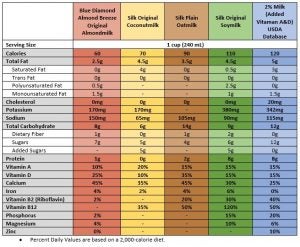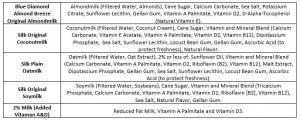The milk aisle can be very overwhelming. There are so many options for dairy milk as well as a large selection of dairy-free “milk” products. So, how do we choose? Well, the answer depends on a number of factors.
Some people can’t tolerate the lactose in dairy, so having non-dairy options is great. There are also a number of lactose-free dairy options, so you don’t have to give up dairy all together if you don’t want to. Your preferences may depend on a number of different aspects such as: taste, special diets (such as vegan), allergies, lactose intolerance, and nutrition. So, which option is the most nutritious, and is there any reason to give up dairy milk if you enjoy it?
First, let’s compare the nutrition facts of almond milk, coconut milk, oat milk, soymilk, and 2% dairy milk.

Here is a comparison of the ingredients:

So, how do they stack up? As you can see, the almond milk and coconut milk are the least nutrient dense. Sure, they have less calories, but it’s because there really isn’t much to them. Oat milk is somewhere in the middle, and soy milk and dairy milk are more nutrient dense with similar nutrient profiles.
Almond milk is made by soaking ground almonds in water and then filtering out the solids. Many people think almond milk is a healthy alternative to dairy milk, however, there’s only 1g of protein per cup, and it’s really not much more than water with a bit of sugar that’s fortified with vitamins.
Coconut milk is a mix of water and coconut cream with some added sugar and vitamins. Again, it’s lower calorie than dairy milk, soy milk, and oat milk, but there is no protein, and it contains a fair amount of saturated fat.
Oat milk falls in the middle as far as calories go, but there’s not much to it either. It’s made by soaking ground oats in water and then filtering out the solids. So, it’s basically just vitamin fortified water with added carbohydrates and a little bit of fat and protein from the oats.
Soy milk has the closest nutrient profile to dairy milk and is fortified with vitamins to closely match real milk. Many soy or non-dairy milks are fortified with calcium to at least match the amount of calcium in dairy milk. That said, your body may not absorb all of the calcium in soy milk since soy contains a natural compound (phytate) that inhibits calcium absorption.
Dairy milk is hard to beat as far as its nutrient profile goes. It is an excellent source of many vitamins and minerals including: calcium, riboflavin, vitamin B12 and phosphorous and a good source of protein, vitamin A, vitamin D, and zinc. If you have a milk allergy or are lactose intolerant, then it’s obviously best to avoid it, however, there are some great lactose-free dairy milk options such as Lactaid and Fairlife. If you are able to tolerate milk without issues, there’s really no health reason to avoid it.
There are many myths surrounding dairy milk, which may be reasons why you’ve chosen to avoid it. I want to make sure to clear up as many of these myths as I can, so that you can make your decisions based on factual information rather than fear.
Dairy myths
Myth #1: Milk is inflammatory: Dairy milk may actually have anti-inflammatory properties in humans not suffering from an allergy to milk.
Myth #2: There is pus in milk: No, there is no pus in milk. Milk contains white blood cells, just like in blood and in human breastmilk. The levels are monitored to ensure that they are below the acceptable amount set by the USDA. Milk with more white blood cells than the limit gets thrown out and never reaches the store.
Myth #3: Humans aren’t made to tolerate dairy: Yes, we are the only animal that consumes dairy into adulthood, but if you don’t have any issues with tolerating it, then there’s no need to avoid it. Even though up until several thousand years ago the lactase enzyme “turned off’ when we reached adulthood, we know now that at least 35 percent of people can digest lactose in adulthood without a hitch.
Myth #4: Dairy milk contains antibiotics: Nope. Every tank of raw milk is checked for antibiotic residues before the milk gets processed. If it tests positive, the milk is rejected for human consumption.
Myth #5: Dairy Milk contains added growth hormones: No. the amount of bST hormone found in the tissues and milk in cows that are treated with rbST compared to cows that don’t receive the hormone is quite similar. Also, cooking and pasteurizing breaks down the hormone.
So, what’s the verdict? Many of the dairy-free “milk” products are not much more than water with some added sugar and vitamins. Out of all of the dairy-free options, soymilk comes closest to dairy milk in terms of nutrition. If you tolerate dairy, there’s no reason to avoid it. If you can’t tolerate lactose, there are some great lactose-free dairy-milk options out there as well. Rest assured that all of these options can be a part of a healthy diet, so use this information to pick your favorite, and remember, you don’t have to pick just one option!
Food Science Babe is the pseudonym of an agvocate and writer who focuses specifically on the science behind our food. She has a degree in chemical engineering and has worked in the food industry for more than decade, both in the conventional and in the natural/organic sectors.



